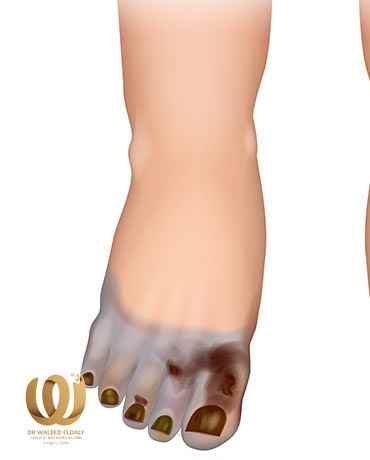Contact us
WhatsApp
Saving the Foot from Amputation by using a Foot Stent
What is the Foot Stent and how is it used to Save the Foot from Amputation?
The foot stent is a small metal tube placed after the dilation of the arteries so that the artery remains open to restore blood flow and supply the tissues with blood loaded with oxygen to nourish them and perform their vital function. There are many types of them such as balloon stents, and bare metal stents.
After the dilation of the artery is completed using the appropriate balloons, the condition of the artery after the dilation is evaluated, and the extent of the response to the dilation. One of the arteries that need stent placement is the femoral arteries, especially in the presence of long occlusion. These stents help to keep the arteries open to allow blood to pass through the limbs, which leads to complete blood flow to the foot, it is also not recommended to use stents in the arteries below the knee.
When Should Stents be Used?
A foot stent should be used if the artery is constricted more than 30% dilation, so the artery will remain open. Stents should also be used if there are cracks in the artery wall after the balloon expansion, in order to maintain blood flow in the artery after the expansion.
After stent placement, the patient must continue on two different types of antiplatelet such as Plavix and Aspirin for a long time.
When Should you Visit a Doctor?
- The feeling of pain increases over time.
- Muscle spasm.
- Difficulty walking.
- Repeated wounds and infections.
- Presence of pus and foul-smelling secretions.
- Swelling in the feet.
What are the Precautions that should be taken to Avoid Amputation?
- Quit Smoking.
- Do regular exercise to improve blood circulation.
- Eat healthy foods and avoid foods rich in fats, which increases the level of cholesterol in the blood.
- Avoid obesity.
- Take care of wounds and avoid any infection or inflammation.
- Maintaining blood glucose level.
- Maintaining blood pressure.
How is the Diagnosis Done?
The initial diagnosis is done by taking the medical history, doing a comprehensive examination of the peripheral blood vessels, doing the tests, doing color Doppler and CT scans on the arteries of the leg to find out the location of the occlusion, and to know the dead tissue in the arteries of the leg and treat it as soon as possible to avoid any serious complications.
Dr. Waleed El-Daly, Assistant Professor of Vascular Surgery at Cairo University and the treatment of diabetic foot, confirmed that peripheral stents play an important role in saving the foot from amputation when the arteries of the legs are blocked. It is one of the best treatments in cases of peripheral artery blockage. He also confirmed on the importance of visiting a doctor and not neglecting the symptoms felt by the patient, as early diagnosis helps to treat the condition and avoid complications significantly; Especially that patients who suffer from narrowing or occlusion in the peripheral arteries in the thigh, leg or foot, are most prone to foot amputation. This type of stent represents the latest findings of the new science in the field of treating atherosclerosis and diabetic foot infections, and it opens the door of a hope to save millions of diabetic patients from amputations because it allows blood to flow back to the limbs, and the patient can leave the hospital on the same day in a good health condition.
Briefly:
If you suffer from occlusion of the peripheral arteries or diabetic foot, you can visit Dr. Waleed El-Daly at the beginning of the injury, where treatment is possible without going for amputation by treating the causes of circulatory failure, which cause lack of blood flow, and the treatment is through therapeutic catheters or dilating the blocked arteries through the therapeutic balloon with the placement of the stent and cleaning the damaged tissues. Studies and research have confirmed a very high reduction in the rate of amputation due to the progress in the technology of stents and catheters that restore blood flow to the limbs.
